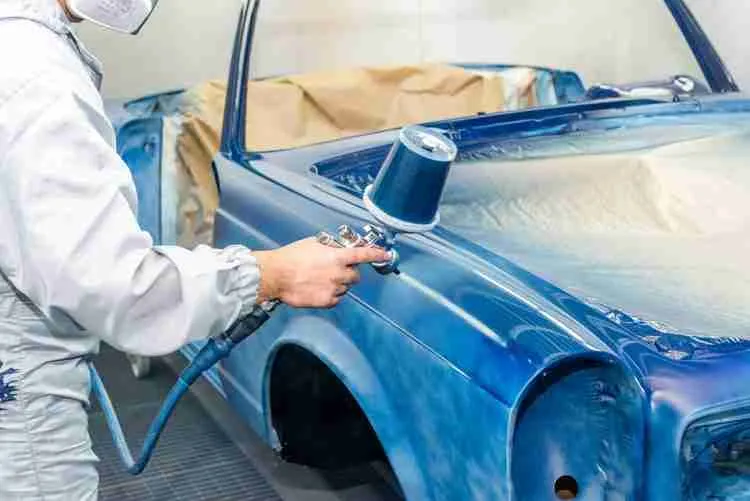Can You Use Spray Paint on a Car-Paint Types and More

Can You Use Spray Paint on a Car
Are you tired of your car’s appearance? Maybe your vehicle is old and rusty, and you want to give it a new lease of life. Or perhaps you’ve just bought your dream car, but you wish that it was a different color.

Professional paint jobs can cost a small fortune, but there’s a much cheaper solution. Spray-painting your vehicle can be just as effective and save you hundreds of dollars.
However, don’t cover your car with spray paint just yet. It’s essential to know everything because not every paint is suitable for vehicles. Good preparation, a lot of care, and the correct equipment are required for a successful outcome.
Check out this guide so that you can paint your car and avoid many common mistakes.
Be Prepared
First, you’ll want the right tools for the job.
Along with the paint, you’ll need a spray gun or air compressor. Meanwhile, you should also acquire an electric sander, paint thinners, wet-and-dry sandpaper, and masking tape. Keep a ready supply of newspapers nearby too.
Dust extractors are not essential but are very useful if you have access to one. Remember to buy safety equipment like face masks and safety glasses.
What Paint Should I Use?
There are different types of paints on the market. Let’s briefly look at the best four of them.
Water-based Paint
This is environment-friendly and commonly used for painting cars. You will need to add a layer of lacquer protection after using this paint. Otherwise, the elements will damage your paintwork over time.
Nitrocellulose Paint
Classic car enthusiasts like this paint because it revitalizes their vehicle without affecting their originality. However, it’s highly toxic, so wear safety gear before using it.
Acrylic Enamel
Enamel paint leaves a tough coating on the car after it dries. Manufacturers heat-treat the paint to make it firmer. It’s also available in aerosol form for easy touch-ups.
Acrylic Urethane
This paint is tough and durable. It’s the most expensive type of spray paint, but it’s very effective. Another compound is required to dry it quickly.
How to Spray Paint Your Car
Now let’s go through the different steps to spray paint your car. Don’t skip any of them if you want to ensure a nice finish.
1. Choose Your Location
First, you should find a suitable place to paint your car, like a large garage. The area must be dust-free and well-ventilated. Make sure that there is plenty of room to move around the vehicle when you’re painting it.
Be aware of potential fire hazards because the paint is highly flammable.
2. Sanding
Now it’s time to get to work!
Before you paint your vehicle, you need to strip it down. Use a sander to remove the clear, top, and base coats. Ideally, you want to strip it down to the bare metal to leave a perfectly smooth surface. You can use an electric sander for larger areas. However, you’ll probably need to do a lot of it by hand using sandpaper.
3. Clean the Exterior
Now you’ll need a cloth and mineral spirits or a silicon cleaner. Then wipe down the entire exterior of the vehicle. This will remove any lingering dust or oil residue.
4. Dismantle and Tape

You don’t want to paint your windows. Use masking tape and newspapers to cover the areas of your car that you want to avoid. If you can remove parts like door handles and grills, you may be able to save time and stress. Otherwise, you’ll have to cover these too.
5. Priming
After stripping your vehicle down to the bare metal, you should prime the surface. Use a corrosion-resistant primer and allow it to cure according to the instructions. Then gently sand the newly primed surfaces again.
Be careful not to sand too deep because you don’t want to expose the bare metal again.
6. Painting
Prepare the paint for spraying by mixing it with thinners. Hold your spray can or gun six inches away from the exterior of the vehicle. Use a horizontal sweeping motion to apply thin and even coats.
It will take three or four coats to cover the vehicle. Remember to follow the recommended drying time between each coat.
7. Sand and Wipe
Before applying the final coat, you should sand the exterior of the vehicle again. This will remove any unwanted residues and ensure a smooth finish. Finally, wipe it down with another clean rag before adding the last coat of paint. When the paint dries, you can remove the masking tape and newspaper.
A Smooth Finish
There are two more steps you need to take if you’re using water-based paint. These will ensure a smooth, clean finish.
Lacquer
After the final coat of paint has dried, you should apply a coat of clear car lacquer. Do this by using the same side-to-side painting technique. This will provide a glossy sheen and protect your new paint job from the elements.
Buff the Surface
The final step is to buff all the panels. This removes a thin layer of paint and takes away any scratches or imperfections. Make sure the lacquer has hardened before you buff your vehicle to ensure a perfect finish. You can buff your vehicle by hand or by using a machine. The problem with the former is that it can be difficult to get even coverage on the paintwork. It’s also easier to miss spots.

There are different types of machine buffers available. We recommend a dual-action or polisher because they are safer to pick up and use. Don’t use a rotary polisher on your car unless you’re experienced because they produce much more heat.
Final Thoughts
Don’t spray-paint your car if you’re not confident about the process. That’s especially important if it’s an expensive vehicle. The risk is significant because a messy finish will affect the resale value. That’s why you can’t take any shortcuts. Be patient and follow all the steps. Allow all the coats of paint to dry before continuing.
Remember to wear safety gear because most spray paints are toxic. It’s also possible to paint your vehicle with a roller. This may be convenient for vans and trucks. You won’t need to wear respiratory protection either.
Spray-painting your vehicle can be an incredibly creative experience. Take your time. Good luck!













No Comment